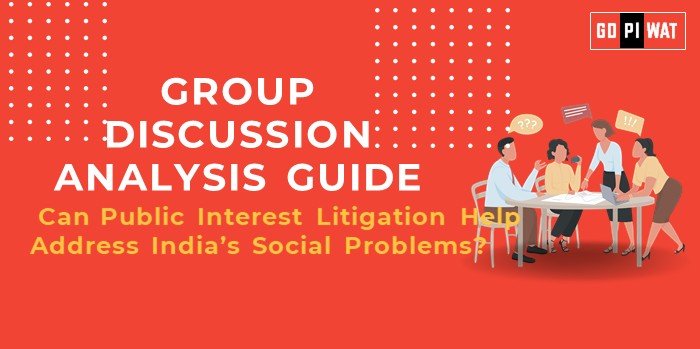📋 Group Discussion (GD) Analysis Guide: Can Public Interest Litigation Help Address India’s Social Problems?
🌐 Introduction to the Topic
- 💬 Opening Context: Public Interest Litigation (PIL) in India has evolved into a crucial tool for judicial activism, addressing issues ranging from environmental protection to human rights violations. It allows individuals or groups to approach courts in the public’s interest without direct personal grievances.
- 📜 Topic Background: The concept of PIL in India took shape in the late 1970s and 1980s, largely through the efforts of Justice P.N. Bhagwati and Justice V.R. Krishna Iyer. Since then, PILs have been instrumental in landmark cases like Vishaka Guidelines for workplace harassment and environmental rulings. However, their growing use has sparked debates on judicial overreach and misuse.
📊 Quick Facts and Key Statistics
- 📜 First Recognized PIL Case: Hussainara Khatoon vs. State of Bihar (1979) addressed prisoners’ rights.
- 🌊 Environment Impact: The Ganga Action Plan originated from a PIL filed in 1985.
- ⚖️ Gender Equality: Vishaka Guidelines were a result of PIL for women’s workplace safety.
- 📈 Number of PILs Filed Annually: Over 5,000 PILs filed annually across Indian courts.
🔍 Stakeholders and Their Roles
- ⚖️ Judiciary: Ensures justice delivery and constitutional adherence.
- 👥 Citizens: Play a key role as petitioners raising social concerns.
- 🏛️ Government and Bureaucracy: Responds to PILs and enacts required measures.
- 📢 NGOs and Activists: Often act as facilitators or petitioners.
🏆 Achievements and Challenges
Achievements:
- 🌱 Environmental Protection: PILs led to bans on plastic bags and forest conservation policies.
- ⚖️ Human Rights: Landmark judgments on custodial deaths and bonded labor eradication.
- 📜 Policy Reform: Pushed for electoral reforms and RTI implementation.
- 🛠️ Social Justice: Mandated free mid-day meals and healthcare access in certain cases.
Challenges:
- ⚖️ Judicial Overreach: Encroaching on legislative and executive domains.
- ❌ Frivolous PILs: Often misused for personal or political gains.
- ⏳ Delayed Justice: Overburdening the judiciary and delaying genuine cases.
- 📍 Accessibility Issues: PILs are still primarily urban-centric.
Global Comparisons:
- 🇺🇸 USA: Class action suits address similar social justice issues.
- 🇿🇦 South Africa: Allows community representatives to challenge constitutional violations.
Case Studies:
- 🚍 Delhi Vehicular Pollution: CNG implementation for public transport stemmed from a PIL.
- 🍛 Right to Food Campaign: Addressed hunger and malnutrition through judicial intervention.
🎯 Structured Arguments for Discussion
- ✅ Supporting Stance: “PILs have been pivotal in ensuring accountability in environmental and social policies, bridging the gap between marginalized communities and governance.”
- ⚖️ Opposing Stance: “The increasing misuse of PILs for publicity or political purposes undermines their credibility and efficiency.”
- 🤝 Balanced Perspective: “While PILs are vital for social justice, stricter guidelines are needed to curb frivolous litigation.”
🗣️ Effective Discussion Approaches
- 📜 Opening Approaches:
- “PILs, introduced in the 1980s, marked a turning point in India’s judicial activism by democratizing justice.”
- “With over 5,000 PILs filed annually, their role in shaping India’s socio-political landscape is undeniable.”
- 🔄 Counter-Argument Handling:
- Use case studies to highlight genuine impacts of PILs (e.g., Vishaka Guidelines).
- Acknowledge concerns but redirect to solutions like stricter filing regulations.
🔍 Strategic Analysis of Strengths and Weaknesses
- 💪 Strengths: Democratic access to justice, tackling systemic inefficiencies.
- 🔧 Weaknesses: Risk of judicial overreach, often inaccessible to rural populations.
- 🌟 Opportunities: Empowering underprivileged communities, addressing contemporary issues like climate change.
- ⚠️ Threats: Rising caseloads, potential misuse by vested interests.
💼 Connecting with B-School Applications
Real-World Applications: Case studies for organizational ethics courses and the role of PILs in Corporate Social Responsibility (CSR) strategies.
Sample Interview Questions:
- 💡 “How can PILs shape India’s governance framework?”
- 💡 “What lessons can the corporate world learn from judicial activism?”
Insights for B-School Students:
- Advocacy skills for CSR initiatives.
- Understanding governance mechanisms for policy implementation.


